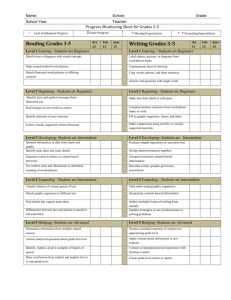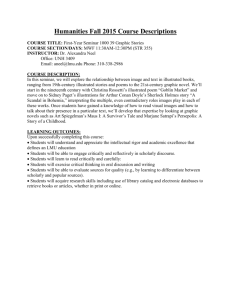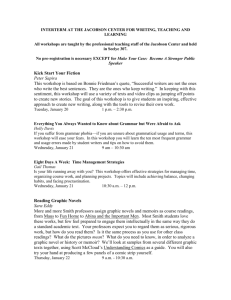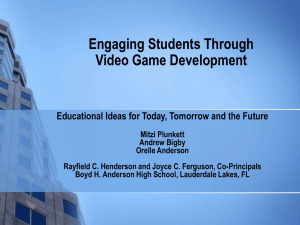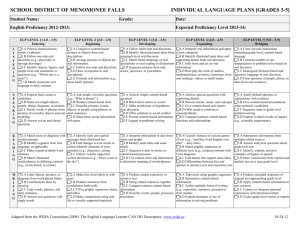Unpacked 3-5 WIDA Standards
advertisement
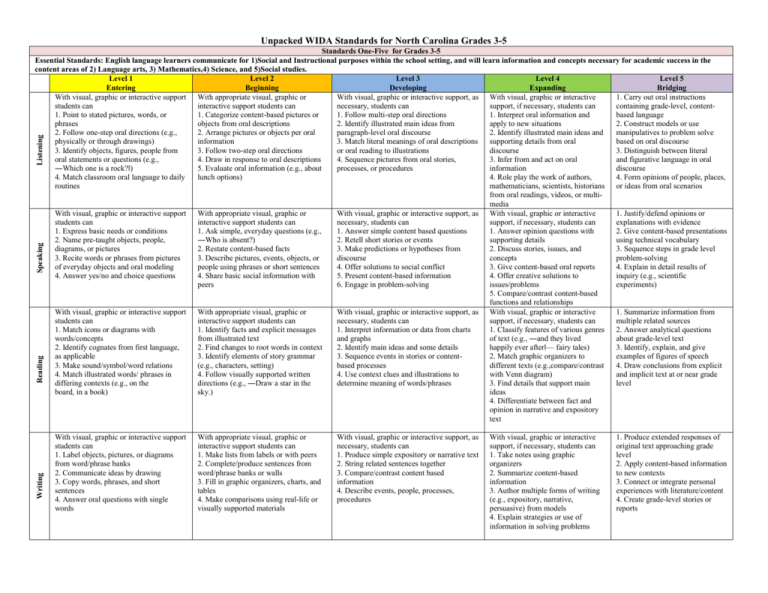
Unpacked WIDA Standards for North Carolina Grades 3-5 Writing Reading Speaking Listening Standards One-Five for Grades 3-5 Essential Standards: English language learners communicate for 1)Social and Instructional purposes within the school setting, and will learn information and concepts necessary for academic success in the content areas of 2) Language arts, 3) Mathematics,4) Science, and 5)Social studies. Level 1 Level 2 Level 3 Level 4 Level 5 Entering Beginning Developing Expanding Bridging With visual, graphic or interactive support With appropriate visual, graphic or With visual, graphic or interactive support, as With visual, graphic or interactive 1. Carry out oral instructions students can interactive support students can necessary, students can support, if necessary, students can containing grade-level, content1. Point to stated pictures, words, or 1. Categorize content-based pictures or 1. Follow multi-step oral directions 1. Interpret oral information and based language phrases objects from oral descriptions 2. Identify illustrated main ideas from apply to new situations 2. Construct models or use 2. Follow one-step oral directions (e.g., 2. Arrange pictures or objects per oral paragraph-level oral discourse 2. Identify illustrated main ideas and manipulatives to problem solve physically or through drawings) information 3. Match literal meanings of oral descriptions supporting details from oral based on oral discourse 3. Identify objects, figures, people from 3. Follow two-step oral directions or oral reading to illustrations discourse 3. Distinguish between literal oral statements or questions (e.g., 4. Draw in response to oral descriptions 4. Sequence pictures from oral stories, 3. Infer from and act on oral and figurative language in oral ―Which one is a rock?‖) 5. Evaluate oral information (e.g., about processes, or procedures information discourse 4. Match classroom oral language to daily lunch options) 4. Role play the work of authors, 4. Form opinions of people, places, routines mathematicians, scientists, historians or ideas from oral scenarios from oral readings, videos, or multimedia With visual, graphic or interactive support With appropriate visual, graphic or With visual, graphic or interactive support, as With visual, graphic or interactive 1. Justify/defend opinions or students can interactive support students can necessary, students can support, if necessary, students can explanations with evidence 1. Express basic needs or conditions 1. Ask simple, everyday questions (e.g., 1. Answer simple content based questions 1. Answer opinion questions with 2. Give content-based presentations 2. Name pre-taught objects, people, ―Who is absent?) 2. Retell short stories or events supporting details using technical vocabulary diagrams, or pictures 2. Restate content-based facts 3. Make predictions or hypotheses from 2. Discuss stories, issues, and 3. Sequence steps in grade level 3. Recite words or phrases from pictures 3. Describe pictures, events, objects, or discourse concepts problem-solving of everyday objects and oral modeling people using phrases or short sentences 4. Offer solutions to social conflict 3. Give content-based oral reports 4. Explain in detail results of 4. Answer yes/no and choice questions 4. Share basic social information with 5. Present content-based information 4. Offer creative solutions to inquiry (e.g., scientific peers 6. Engage in problem-solving issues/problems experiments) 5. Compare/contrast content-based functions and relationships With visual, graphic or interactive support With appropriate visual, graphic or With visual, graphic or interactive support, as With visual, graphic or interactive 1. Summarize information from students can interactive support students can necessary, students can support, if necessary, students can multiple related sources 1. Match icons or diagrams with 1. Identify facts and explicit messages 1. Interpret information or data from charts 1. Classify features of various genres 2. Answer analytical questions words/concepts from illustrated text and graphs of text (e.g., ―and they lived about grade-level text 2. Identify cognates from first language, 2. Find changes to root words in context 2. Identify main ideas and some details happily ever after‖— fairy tales) 3. Identify, explain, and give as applicable 3. Identify elements of story grammar 3. Sequence events in stories or content2. Match graphic organizers to examples of figures of speech 3. Make sound/symbol/word relations (e.g., characters, setting) based processes different texts (e.g.,compare/contrast 4. Draw conclusions from explicit 4. Match illustrated words/ phrases in 4. Follow visually supported written 4. Use context clues and illustrations to with Venn diagram) and implicit text at or near grade differing contexts (e.g., on the directions (e.g., ―Draw a star in the determine meaning of words/phrases 3. Find details that support main level board, in a book) sky.) ideas 4. Differentiate between fact and opinion in narrative and expository text With visual, graphic or interactive support students can 1. Label objects, pictures, or diagrams from word/phrase banks 2. Communicate ideas by drawing 3. Copy words, phrases, and short sentences 4. Answer oral questions with single words With appropriate visual, graphic or interactive support students can 1. Make lists from labels or with peers 2. Complete/produce sentences from word/phrase banks or walls 3. Fill in graphic organizers, charts, and tables 4. Make comparisons using real-life or visually supported materials With visual, graphic or interactive support, as necessary, students can 1. Produce simple expository or narrative text 2. String related sentences together 3. Compare/contrast content based information 4. Describe events, people, processes, procedures With visual, graphic or interactive support, if necessary, students can 1. Take notes using graphic organizers 2. Summarize content-based information 3. Author multiple forms of writing (e.g., expository, narrative, persuasive) from models 4. Explain strategies or use of information in solving problems 1. Produce extended responses of original text approaching grade level 2. Apply content-based information to new contexts 3. Connect or integrate personal experiences with literature/content 4. Create grade-level stories or reports
